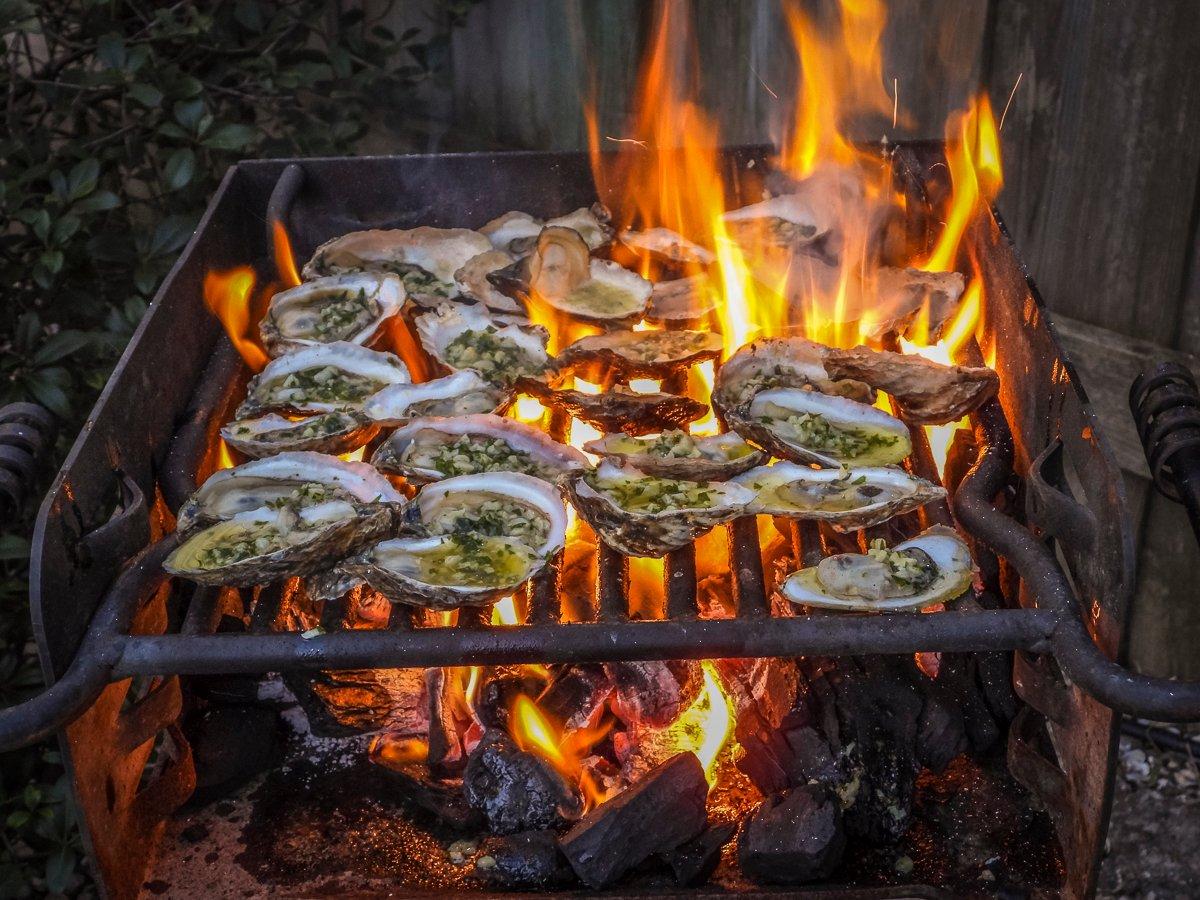Fire up the grill to prepare this garlicky, buttery, cheesy shellfish dish
Chargrilled Oysters
30 Min
Prep Time
10 Min
Cook Time
2-6
Servings
Easy
Difficulty
Back when our now college-aged kids were babies, we decided to quit the condos and high rises in the touristy areas of the Gulf Coast. We searched around and found Apalachicola, East Point, and St. George Island, and the Apalachicola Bay that separated the three. We loved the laid-back little fishing towns, Old Florida at its best, and have been going back several times a year since.
One of the first things we noticed about the bay was the oystermen and women who depended on it to make a living. They still did it old-school here, wooden boats, often hand built, and long oyster tongs used to rake along the submerged beds, pulling up clumps of oysters to be hand sorted according to size. We'd grab our coffee and head down to the waterfront at dawn to watch the fleet head out each morning. Grizzled old hands that had done it all their life, and young men and women raised in oystering families, they would launch in waves, like bass fishermen at a big tournament, until the shallow waters of the bay were dotted all over with the small boats.
The Apalachicola Bay has been home to some of the best-tasting oysters in the world since well before the first Europeans ever set foot on the continent. Archaeological digs have dated civilizations in the area as far back as 15,000 years. Fresh water flowing down the Apalachicola River blended with salt water from the Gulf of Mexico to form the perfect habitat for oysters, and the natives ate them with gusto, mounding piles of shells like small mountains. Many of those shell mounds still exist today.
Sadly, recent years have seen a serious decline in the local oyster population. It isn't any one factor that has impacted the oysters, but rather a combination of things. Increased water demands on the river as it flows through urban and farm areas of Georgia have decreased the amount of fresh water flowing into the bay. And a man-made cut that now separates St. George Island from Little St. George, built to give commercial and recreational boat traffic a faster route to the Gulf, has increased the amount of saltwater flowing into the lower portion of the bay. This has raised salinity levels to the point that saltwater predators like black drum have encroached into the bay area, feeding heavily on the immature oysters in the beds.
The latest hit came with the BP oil spill a few years ago. Fears that the oil would reach the bay prompted a hold on size and number limits on oysters. The oystermen and women hit the water with everything they had, pulling as many oysters of all sizes as possible before the oil destroyed the beds for years to come. It never did. The oil slick stopped well before reaching the bay, but the fishery had been hit hard. A five-year moratorium on all oyster harvest from the Apalachicola Bay was put into place to allow populations to recover.
Luckily, there are still places along the Panhandle where you can wade out and pick up a few oysters for yourself if you are in the mood. And, absent the commercial harvest for the prized Apalach oyster, a new industry has emerged. Oyster farmers like father-and-son team Jeff and Reid Tilley at Oyster Boss, headquartered in Sopchoppy, Florida, have started raising farmed oysters in these same waters. Tiny seed oysters are placed in grow-out baskets suspended in the water by rafts of plastic floats. The oysters grow quickly in the nutrient-rich water while being relatively protected from predators.
The team at Oyster Boss also sustainably harvests wild oysters in locations outside the bay where populations are more stable. I've had both the farmed and the wild caught they offer. I'll put either up against any oyster I've eaten from the Texas Gulf all the way up the East Coast.
Wherever you get your oysters, use a few in this recipe, my second favorite behind just eating them raw with a splash of Crystal hot sauce. You'll need a hot grill, but the resulting salty, smoky treat is worth it.
Ingredients
2 dozen shucked oysters, in the bottom shell
1 pound butter
1 entire head of garlic, finely chopped
1 large bunch of fresh flat-leaf parsley, chopped
1 teaspoon black pepper
1/2 teaspoon dried oregano
3 ounces grated Parmesan cheese or a blend of Parmesan and Romano cheeses
Cooking Instructions
While shucking the oysters, take care to preserve as much of the briny liquid as possible inside the bottom shell. Leave the oyster attached to the bottom shell to prevent it slipping off and down into the coals as the oysters grill.
Spoon the garlic butter onto each oyster, allowing a bit to spill over onto the coals, causing flames to flare up and around the oysters.
Garnish with a pinch of the remaining chopped parsley. Serve with lemon wedges and hot sauce, if desired.











